Strategic Analysis of HR Strategies for Competitive Advantage
VerifiedAdded on 2023/06/12
|6
|1266
|348
Essay
AI Summary
This paper provides a strategic analysis of how human resource strategies can give a competitive advantage to knowledge-based organizations in today's fast-paced global economy. It emphasizes the importance of rewards in motivating performance, short-term training for keeping abreast of technology changes, workforce development through corporate training and flexible work arrangements, and leadership management for addressing pressures from customers, employees, and shareholders. The essay further discusses organizational development for engaging employees and setting SMART objectives to guide the organization's strategic direction. Performance metrics are crucial for measuring organizational performance and guiding strategic change. The conclusion highlights that employees are a major factor that sets a business apart from its competitors, and their quality, satisfaction, and enthusiasm have an important impact on the organization’s competitive advantage.
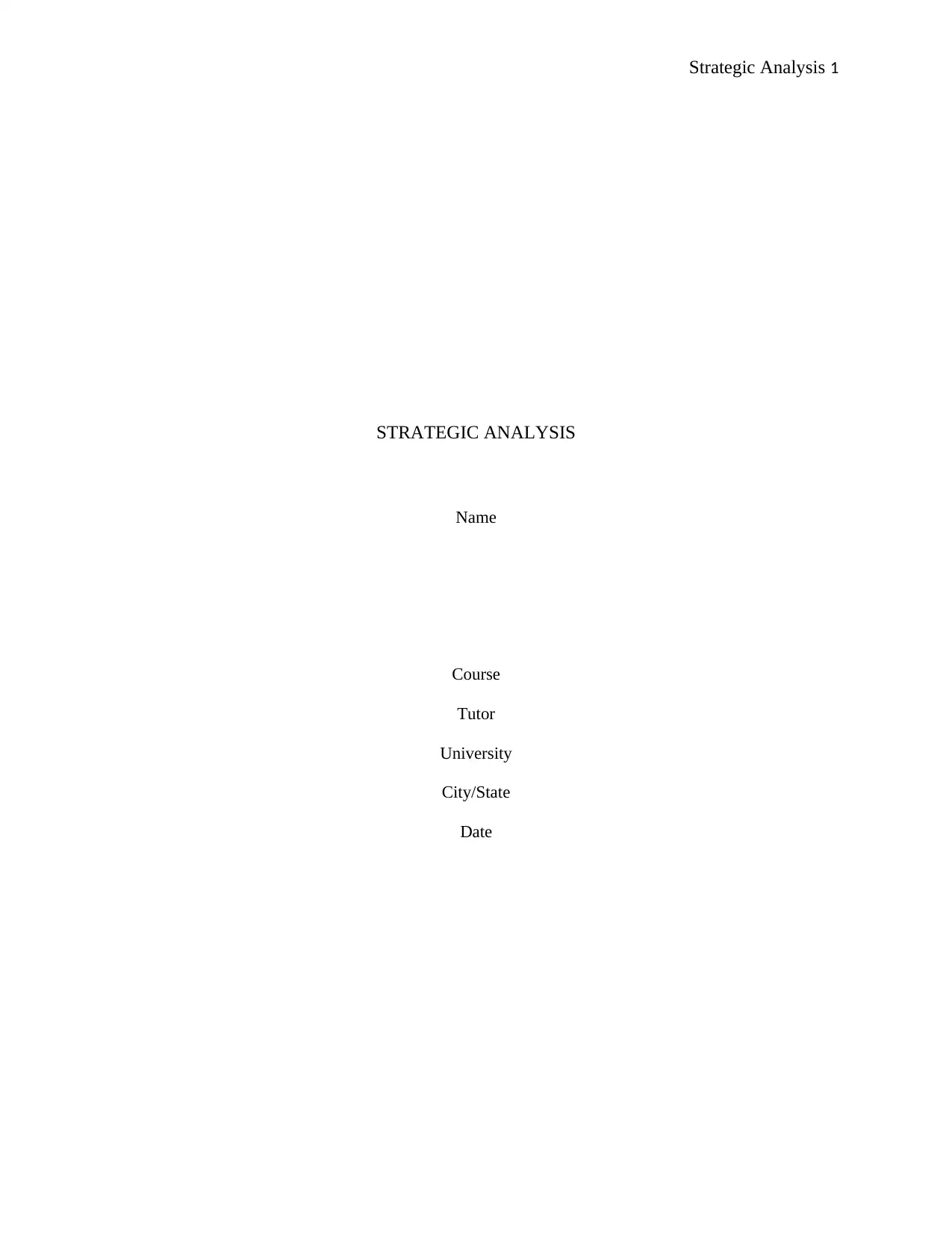
Strategic Analysis 1
STRATEGIC ANALYSIS
Name
Course
Tutor
University
City/State
Date
STRATEGIC ANALYSIS
Name
Course
Tutor
University
City/State
Date
Paraphrase This Document
Need a fresh take? Get an instant paraphrase of this document with our AI Paraphraser
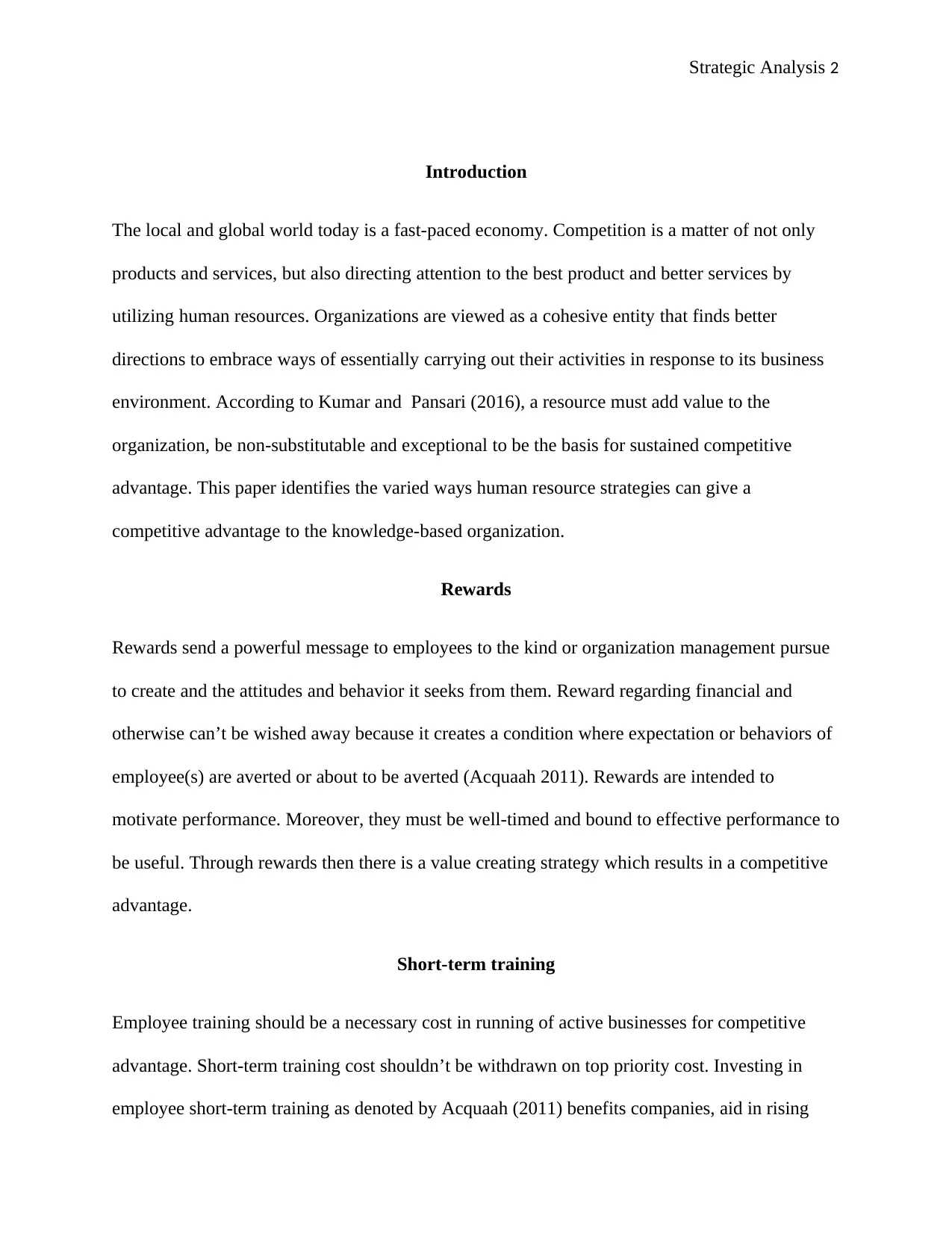
Strategic Analysis 2
Introduction
The local and global world today is a fast-paced economy. Competition is a matter of not only
products and services, but also directing attention to the best product and better services by
utilizing human resources. Organizations are viewed as a cohesive entity that finds better
directions to embrace ways of essentially carrying out their activities in response to its business
environment. According to Kumar and Pansari (2016), a resource must add value to the
organization, be non-substitutable and exceptional to be the basis for sustained competitive
advantage. This paper identifies the varied ways human resource strategies can give a
competitive advantage to the knowledge-based organization.
Rewards
Rewards send a powerful message to employees to the kind or organization management pursue
to create and the attitudes and behavior it seeks from them. Reward regarding financial and
otherwise can’t be wished away because it creates a condition where expectation or behaviors of
employee(s) are averted or about to be averted (Acquaah 2011). Rewards are intended to
motivate performance. Moreover, they must be well-timed and bound to effective performance to
be useful. Through rewards then there is a value creating strategy which results in a competitive
advantage.
Short-term training
Employee training should be a necessary cost in running of active businesses for competitive
advantage. Short-term training cost shouldn’t be withdrawn on top priority cost. Investing in
employee short-term training as denoted by Acquaah (2011) benefits companies, aid in rising
Introduction
The local and global world today is a fast-paced economy. Competition is a matter of not only
products and services, but also directing attention to the best product and better services by
utilizing human resources. Organizations are viewed as a cohesive entity that finds better
directions to embrace ways of essentially carrying out their activities in response to its business
environment. According to Kumar and Pansari (2016), a resource must add value to the
organization, be non-substitutable and exceptional to be the basis for sustained competitive
advantage. This paper identifies the varied ways human resource strategies can give a
competitive advantage to the knowledge-based organization.
Rewards
Rewards send a powerful message to employees to the kind or organization management pursue
to create and the attitudes and behavior it seeks from them. Reward regarding financial and
otherwise can’t be wished away because it creates a condition where expectation or behaviors of
employee(s) are averted or about to be averted (Acquaah 2011). Rewards are intended to
motivate performance. Moreover, they must be well-timed and bound to effective performance to
be useful. Through rewards then there is a value creating strategy which results in a competitive
advantage.
Short-term training
Employee training should be a necessary cost in running of active businesses for competitive
advantage. Short-term training cost shouldn’t be withdrawn on top priority cost. Investing in
employee short-term training as denoted by Acquaah (2011) benefits companies, aid in rising
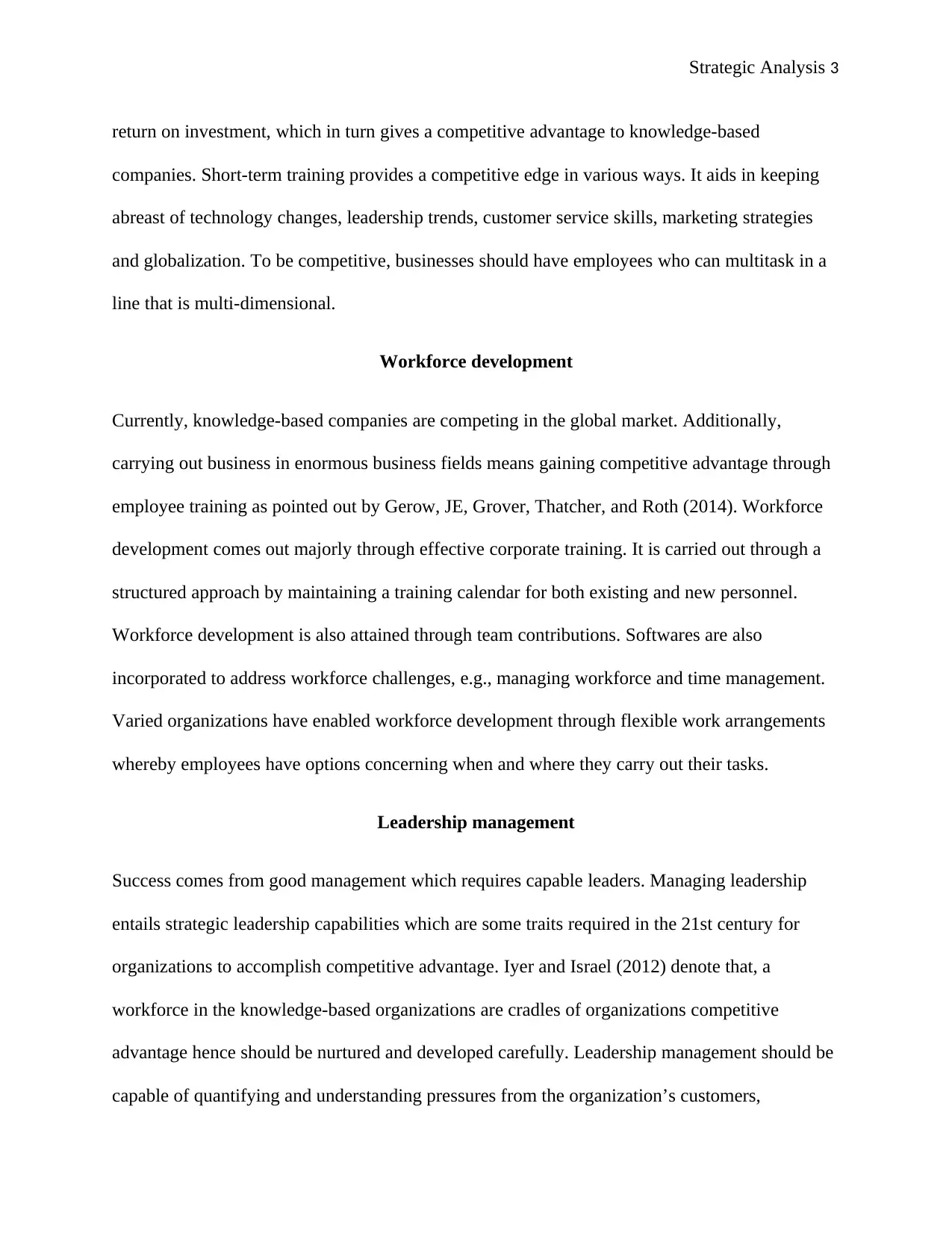
Strategic Analysis 3
return on investment, which in turn gives a competitive advantage to knowledge-based
companies. Short-term training provides a competitive edge in various ways. It aids in keeping
abreast of technology changes, leadership trends, customer service skills, marketing strategies
and globalization. To be competitive, businesses should have employees who can multitask in a
line that is multi-dimensional.
Workforce development
Currently, knowledge-based companies are competing in the global market. Additionally,
carrying out business in enormous business fields means gaining competitive advantage through
employee training as pointed out by Gerow, JE, Grover, Thatcher, and Roth (2014). Workforce
development comes out majorly through effective corporate training. It is carried out through a
structured approach by maintaining a training calendar for both existing and new personnel.
Workforce development is also attained through team contributions. Softwares are also
incorporated to address workforce challenges, e.g., managing workforce and time management.
Varied organizations have enabled workforce development through flexible work arrangements
whereby employees have options concerning when and where they carry out their tasks.
Leadership management
Success comes from good management which requires capable leaders. Managing leadership
entails strategic leadership capabilities which are some traits required in the 21st century for
organizations to accomplish competitive advantage. Iyer and Israel (2012) denote that, a
workforce in the knowledge-based organizations are cradles of organizations competitive
advantage hence should be nurtured and developed carefully. Leadership management should be
capable of quantifying and understanding pressures from the organization’s customers,
return on investment, which in turn gives a competitive advantage to knowledge-based
companies. Short-term training provides a competitive edge in various ways. It aids in keeping
abreast of technology changes, leadership trends, customer service skills, marketing strategies
and globalization. To be competitive, businesses should have employees who can multitask in a
line that is multi-dimensional.
Workforce development
Currently, knowledge-based companies are competing in the global market. Additionally,
carrying out business in enormous business fields means gaining competitive advantage through
employee training as pointed out by Gerow, JE, Grover, Thatcher, and Roth (2014). Workforce
development comes out majorly through effective corporate training. It is carried out through a
structured approach by maintaining a training calendar for both existing and new personnel.
Workforce development is also attained through team contributions. Softwares are also
incorporated to address workforce challenges, e.g., managing workforce and time management.
Varied organizations have enabled workforce development through flexible work arrangements
whereby employees have options concerning when and where they carry out their tasks.
Leadership management
Success comes from good management which requires capable leaders. Managing leadership
entails strategic leadership capabilities which are some traits required in the 21st century for
organizations to accomplish competitive advantage. Iyer and Israel (2012) denote that, a
workforce in the knowledge-based organizations are cradles of organizations competitive
advantage hence should be nurtured and developed carefully. Leadership management should be
capable of quantifying and understanding pressures from the organization’s customers,
⊘ This is a preview!⊘
Do you want full access?
Subscribe today to unlock all pages.

Trusted by 1+ million students worldwide
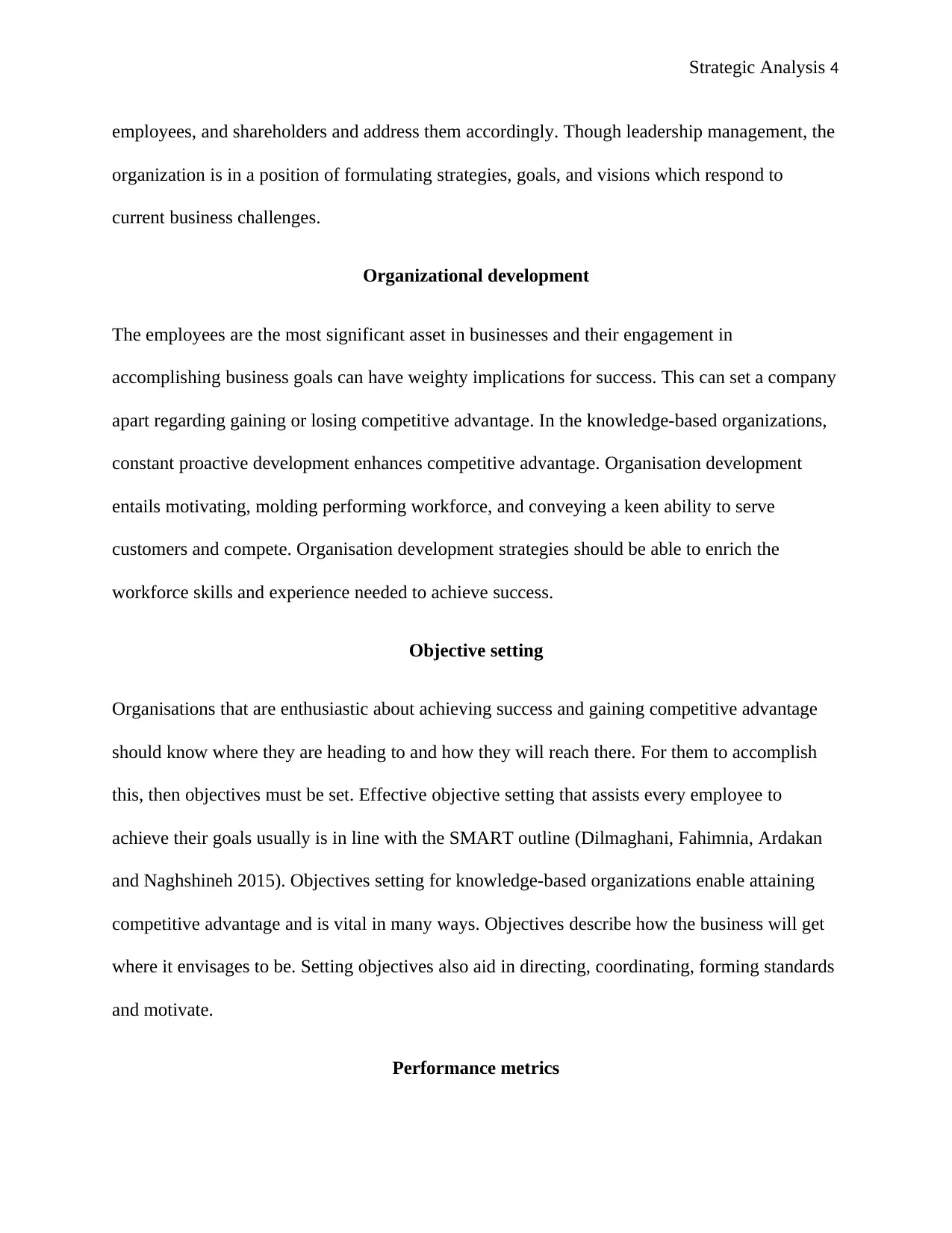
Strategic Analysis 4
employees, and shareholders and address them accordingly. Though leadership management, the
organization is in a position of formulating strategies, goals, and visions which respond to
current business challenges.
Organizational development
The employees are the most significant asset in businesses and their engagement in
accomplishing business goals can have weighty implications for success. This can set a company
apart regarding gaining or losing competitive advantage. In the knowledge-based organizations,
constant proactive development enhances competitive advantage. Organisation development
entails motivating, molding performing workforce, and conveying a keen ability to serve
customers and compete. Organisation development strategies should be able to enrich the
workforce skills and experience needed to achieve success.
Objective setting
Organisations that are enthusiastic about achieving success and gaining competitive advantage
should know where they are heading to and how they will reach there. For them to accomplish
this, then objectives must be set. Effective objective setting that assists every employee to
achieve their goals usually is in line with the SMART outline (Dilmaghani, Fahimnia, Ardakan
and Naghshineh 2015). Objectives setting for knowledge-based organizations enable attaining
competitive advantage and is vital in many ways. Objectives describe how the business will get
where it envisages to be. Setting objectives also aid in directing, coordinating, forming standards
and motivate.
Performance metrics
employees, and shareholders and address them accordingly. Though leadership management, the
organization is in a position of formulating strategies, goals, and visions which respond to
current business challenges.
Organizational development
The employees are the most significant asset in businesses and their engagement in
accomplishing business goals can have weighty implications for success. This can set a company
apart regarding gaining or losing competitive advantage. In the knowledge-based organizations,
constant proactive development enhances competitive advantage. Organisation development
entails motivating, molding performing workforce, and conveying a keen ability to serve
customers and compete. Organisation development strategies should be able to enrich the
workforce skills and experience needed to achieve success.
Objective setting
Organisations that are enthusiastic about achieving success and gaining competitive advantage
should know where they are heading to and how they will reach there. For them to accomplish
this, then objectives must be set. Effective objective setting that assists every employee to
achieve their goals usually is in line with the SMART outline (Dilmaghani, Fahimnia, Ardakan
and Naghshineh 2015). Objectives setting for knowledge-based organizations enable attaining
competitive advantage and is vital in many ways. Objectives describe how the business will get
where it envisages to be. Setting objectives also aid in directing, coordinating, forming standards
and motivate.
Performance metrics
Paraphrase This Document
Need a fresh take? Get an instant paraphrase of this document with our AI Paraphraser
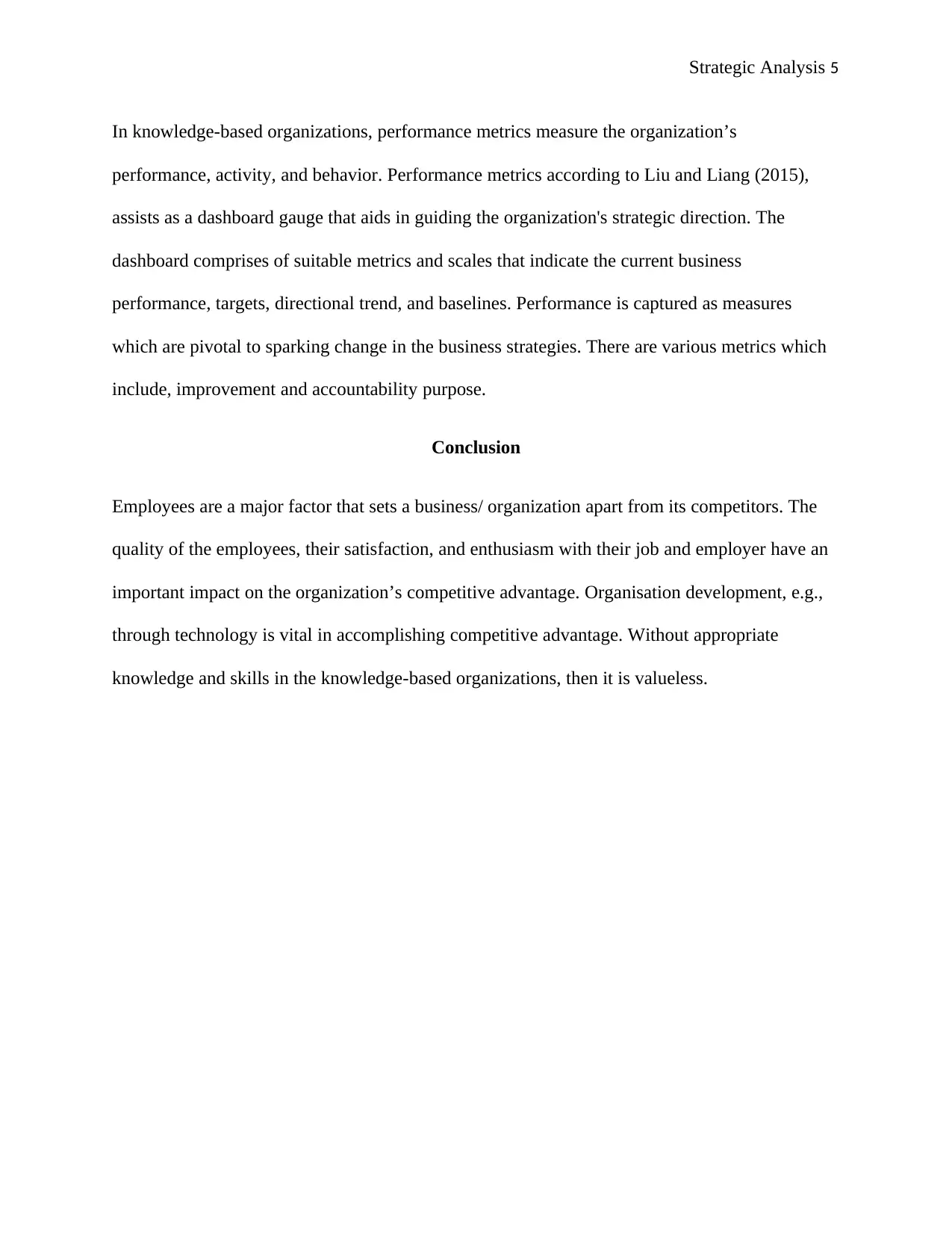
Strategic Analysis 5
In knowledge-based organizations, performance metrics measure the organization’s
performance, activity, and behavior. Performance metrics according to Liu and Liang (2015),
assists as a dashboard gauge that aids in guiding the organization's strategic direction. The
dashboard comprises of suitable metrics and scales that indicate the current business
performance, targets, directional trend, and baselines. Performance is captured as measures
which are pivotal to sparking change in the business strategies. There are various metrics which
include, improvement and accountability purpose.
Conclusion
Employees are a major factor that sets a business/ organization apart from its competitors. The
quality of the employees, their satisfaction, and enthusiasm with their job and employer have an
important impact on the organization’s competitive advantage. Organisation development, e.g.,
through technology is vital in accomplishing competitive advantage. Without appropriate
knowledge and skills in the knowledge-based organizations, then it is valueless.
In knowledge-based organizations, performance metrics measure the organization’s
performance, activity, and behavior. Performance metrics according to Liu and Liang (2015),
assists as a dashboard gauge that aids in guiding the organization's strategic direction. The
dashboard comprises of suitable metrics and scales that indicate the current business
performance, targets, directional trend, and baselines. Performance is captured as measures
which are pivotal to sparking change in the business strategies. There are various metrics which
include, improvement and accountability purpose.
Conclusion
Employees are a major factor that sets a business/ organization apart from its competitors. The
quality of the employees, their satisfaction, and enthusiasm with their job and employer have an
important impact on the organization’s competitive advantage. Organisation development, e.g.,
through technology is vital in accomplishing competitive advantage. Without appropriate
knowledge and skills in the knowledge-based organizations, then it is valueless.
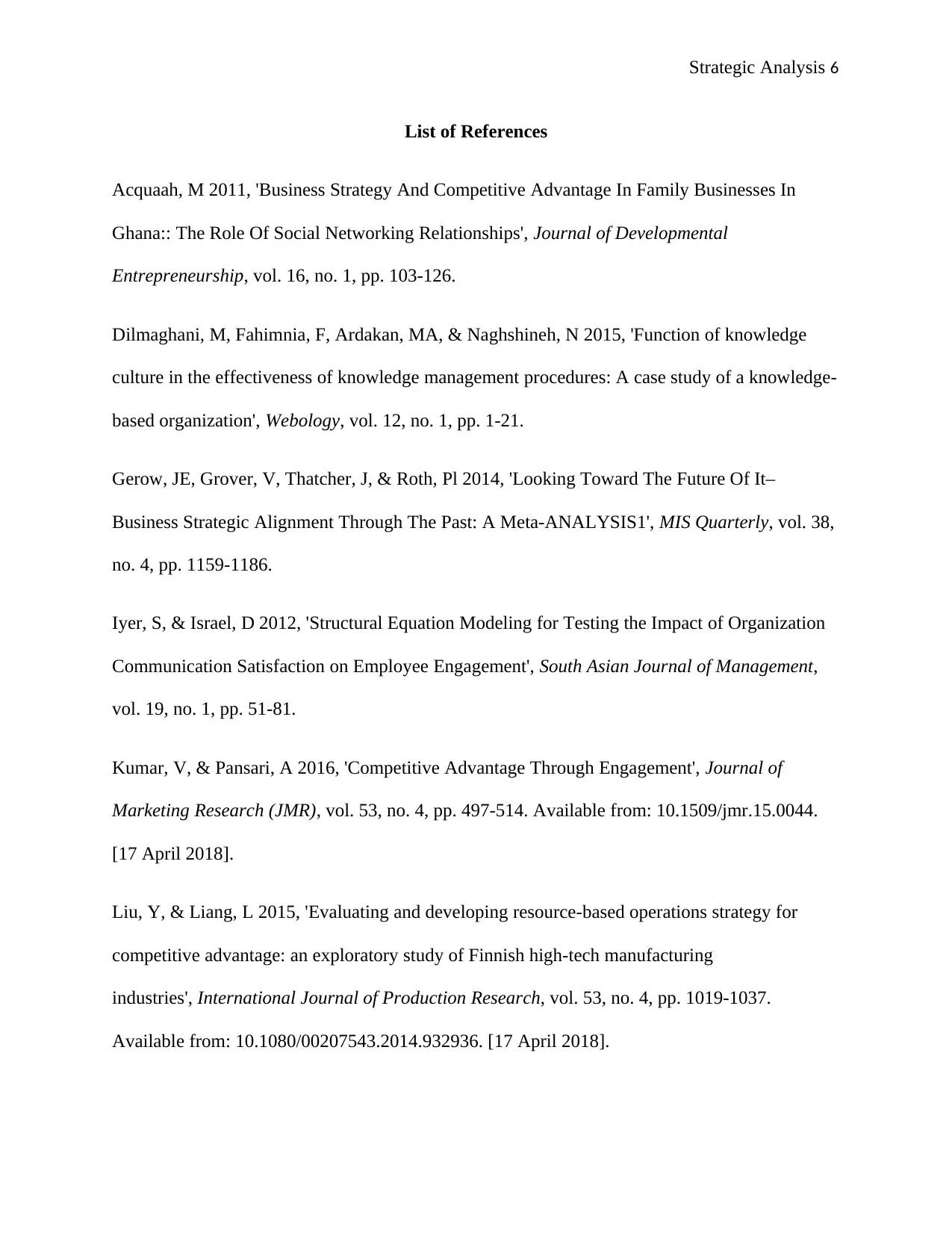
Strategic Analysis 6
List of References
Acquaah, M 2011, 'Business Strategy And Competitive Advantage In Family Businesses In
Ghana:: The Role Of Social Networking Relationships', Journal of Developmental
Entrepreneurship, vol. 16, no. 1, pp. 103-126.
Dilmaghani, M, Fahimnia, F, Ardakan, MA, & Naghshineh, N 2015, 'Function of knowledge
culture in the effectiveness of knowledge management procedures: A case study of a knowledge-
based organization', Webology, vol. 12, no. 1, pp. 1-21.
Gerow, JE, Grover, V, Thatcher, J, & Roth, Pl 2014, 'Looking Toward The Future Of It–
Business Strategic Alignment Through The Past: A Meta-ANALYSIS1', MIS Quarterly, vol. 38,
no. 4, pp. 1159-1186.
Iyer, S, & Israel, D 2012, 'Structural Equation Modeling for Testing the Impact of Organization
Communication Satisfaction on Employee Engagement', South Asian Journal of Management,
vol. 19, no. 1, pp. 51-81.
Kumar, V, & Pansari, A 2016, 'Competitive Advantage Through Engagement', Journal of
Marketing Research (JMR), vol. 53, no. 4, pp. 497-514. Available from: 10.1509/jmr.15.0044.
[17 April 2018].
Liu, Y, & Liang, L 2015, 'Evaluating and developing resource-based operations strategy for
competitive advantage: an exploratory study of Finnish high-tech manufacturing
industries', International Journal of Production Research, vol. 53, no. 4, pp. 1019-1037.
Available from: 10.1080/00207543.2014.932936. [17 April 2018].
List of References
Acquaah, M 2011, 'Business Strategy And Competitive Advantage In Family Businesses In
Ghana:: The Role Of Social Networking Relationships', Journal of Developmental
Entrepreneurship, vol. 16, no. 1, pp. 103-126.
Dilmaghani, M, Fahimnia, F, Ardakan, MA, & Naghshineh, N 2015, 'Function of knowledge
culture in the effectiveness of knowledge management procedures: A case study of a knowledge-
based organization', Webology, vol. 12, no. 1, pp. 1-21.
Gerow, JE, Grover, V, Thatcher, J, & Roth, Pl 2014, 'Looking Toward The Future Of It–
Business Strategic Alignment Through The Past: A Meta-ANALYSIS1', MIS Quarterly, vol. 38,
no. 4, pp. 1159-1186.
Iyer, S, & Israel, D 2012, 'Structural Equation Modeling for Testing the Impact of Organization
Communication Satisfaction on Employee Engagement', South Asian Journal of Management,
vol. 19, no. 1, pp. 51-81.
Kumar, V, & Pansari, A 2016, 'Competitive Advantage Through Engagement', Journal of
Marketing Research (JMR), vol. 53, no. 4, pp. 497-514. Available from: 10.1509/jmr.15.0044.
[17 April 2018].
Liu, Y, & Liang, L 2015, 'Evaluating and developing resource-based operations strategy for
competitive advantage: an exploratory study of Finnish high-tech manufacturing
industries', International Journal of Production Research, vol. 53, no. 4, pp. 1019-1037.
Available from: 10.1080/00207543.2014.932936. [17 April 2018].
⊘ This is a preview!⊘
Do you want full access?
Subscribe today to unlock all pages.

Trusted by 1+ million students worldwide
1 out of 6
Related Documents
Your All-in-One AI-Powered Toolkit for Academic Success.
+13062052269
info@desklib.com
Available 24*7 on WhatsApp / Email
![[object Object]](/_next/static/media/star-bottom.7253800d.svg)
Unlock your academic potential
Copyright © 2020–2025 A2Z Services. All Rights Reserved. Developed and managed by ZUCOL.





